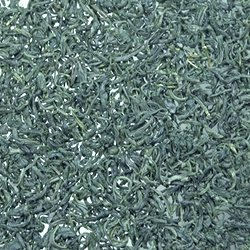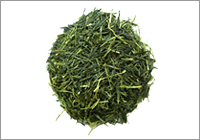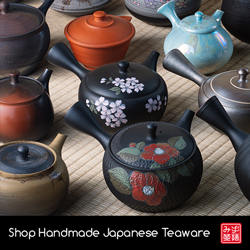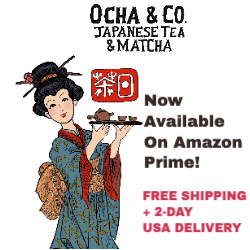 Kamairicha (釜炒り茶, pan fried tea) is different from most Japanese green teas in that it’s not steamed but pan fried, like the Chinese do.
Kamairicha (釜炒り茶, pan fried tea) is different from most Japanese green teas in that it’s not steamed but pan fried, like the Chinese do.
It has a mild roasted flavor and aroma.
The two types of kamairicha
Generally speaking, there are two types of kamairicha:
Kamairi tamaryokucha (釜炒り玉緑茶, pan fried ball green tea)
Unlike steamed tamaryokucha, the tea leaves are pan fried in this case. The cultivation and further processing is the same, making the tea leaves look curly at the end.
Sometimes people refer to this tea as kamaguri (釜ぐり).
 Kamanobicha (釜伸び茶, pan stretched tea)
Kamanobicha (釜伸び茶, pan stretched tea)
This tea is also pan fried but at the final processing the leaves are rolled just like sencha, so that it takes the familiar needle-shape.
Sometimes people will just say kamairicha to refer to either of the two types, so it can be confusing.
The best way to tell would be by the shape of the tea leaves. Anyway, pan fried teas produced in Japan only amount to about 5% of the total production, and out of that kamairi tamaryokucha is far more common.
History of kamairicha
The pan frying method first became popular in China during the start of the Ming dynasty, and even now is the preferred method of stopping the oxidation process of the tea leaves in Chinese teas.
The pan frying method by using the kama (iron pot) was brought to northern Kyushu by the Chinese in the fifteenth century. However, Japan later adopted the steaming method.
Nowadays, the pan frying method is considered to be rare in Japan. Please read the post about green tea history for more information.
Pan frying process
There are 2 traditional ways to make kamairicha, and that distinction has come to be used as a tea brand for kamairi tamaryokucha in the respective prefectures.
Ureshino (嬉野)
Ureshino tea is made in the Saga prefecture, where the city of Ureshino is located. The traditional kamairi process involves a kama that is slanted at 45 degrees.
Check out the video below to see the pan frying of ureshinocha:
Aoyanagi (青柳)
Aoyanagi tea is a product from the Kumamoto prefecture. The kama is a multipurpose pan, unlike the special kama used in ureshino tea. It’s placed parallel to the ground.
I’ve also included a video for you to see the different position of the kama:
Unfortunately, the traditional process has been largely displaced by the use of machines. I don’t think I’ve tried kamairi tamaryokucha made manually yet.
How to brew kamairicha
Kamairicha is brewed much like sencha, except that the water temperature is a bit higher, 90 °C (194 °F).
For each cup, use a teaspoon of kamairicha (4 grams), 60 ml of water at 90 °C (194 °F), and let steep for 1 minute.
Since there are different types of kamairicha, perhaps it’s best to follow the manufacturer’s instructions for a higher-quality brew.






January 9, 2017
Thank you so much for your wonderful website! I have just found an amazing shop that works with small (organic/sustainable) tea producers from Japan and they have a rare kamairicha apparently still panfried by hand 🙂 am going to give it a try after reading your post!
January 10, 2017
Hi Shaini
Thank you for your comment. Enjoy your tea!
September 3, 2019
Hi, it’s still Eugène, I just wrote a question on your page concerning Tamaryokucha.
Well, after reading your guide, I brewed a Kamairicha from Gokase in a gaiwan (4,8 grams/ 100 ml /90°C/ 60 seconds) I found the infusion extremely bitter in comparison to Long Jing/ Biluochun and Huangshan Maofeng. (I brew them also in a gaiwan ( 3.5/ 100ml /15-20 seconds for the first infusion 75-85°C) there must be some culture shock here. Again, I have the same question, are the japanese teas much more bitter than the chinese green teas… True, since Kamairicha is a pan-fried tea, it tastes similar to Lu An Gua Pian or to Long Jing.
Sincerely,
Eugène
September 3, 2019
Hi Eugene
It’s hard to know without trying your tea.
Japanese teas often have much more umami flavor than Chinese ones (it feels more dense, like a broth) and they feel more vegetal/marine. Chinese green tea can have more sweetness and can be brewed for longer and with more temperature without becoming too bitter.
I can tell when a Japanese green tea is bitter, but maybe my tolerance is higher than you. So that what you find bitter might not feel bitter at all for many Japanese tea drinkers.
Perhaps try a cold infusion (brewing in cold water), and see if it’s still bitter. If you still find it bitter, then it means that you are very sensitive to bitterness, because with low temperature very little bitterness and astringency gets infused.
September 3, 2019
Thank you for your advice.
I would recommand you Lu An Gua Pian. It’s a pan-fried green tea which has a similar taste to the Kamairicha from Gokase that I just tried(the cultivar is unknown… these tea sellers in Paris never tell you the cultivar of their teas). For the way of brewing Lu An Gua Pian, I would recommand you to use a Gaiwan: 3.5g/ 100ml /90 °C/ 20 seconds for the first infusion, then 25 for the second infusion, 30 for the third..etc
https://en.wikipedia.org/wiki/Lu%27an_Melon_Seed_tea
Have a nice day.
cordially,
Eugène
September 3, 2019
Thank you Eugene.
I will definitely try this tea. I have heard of it before.